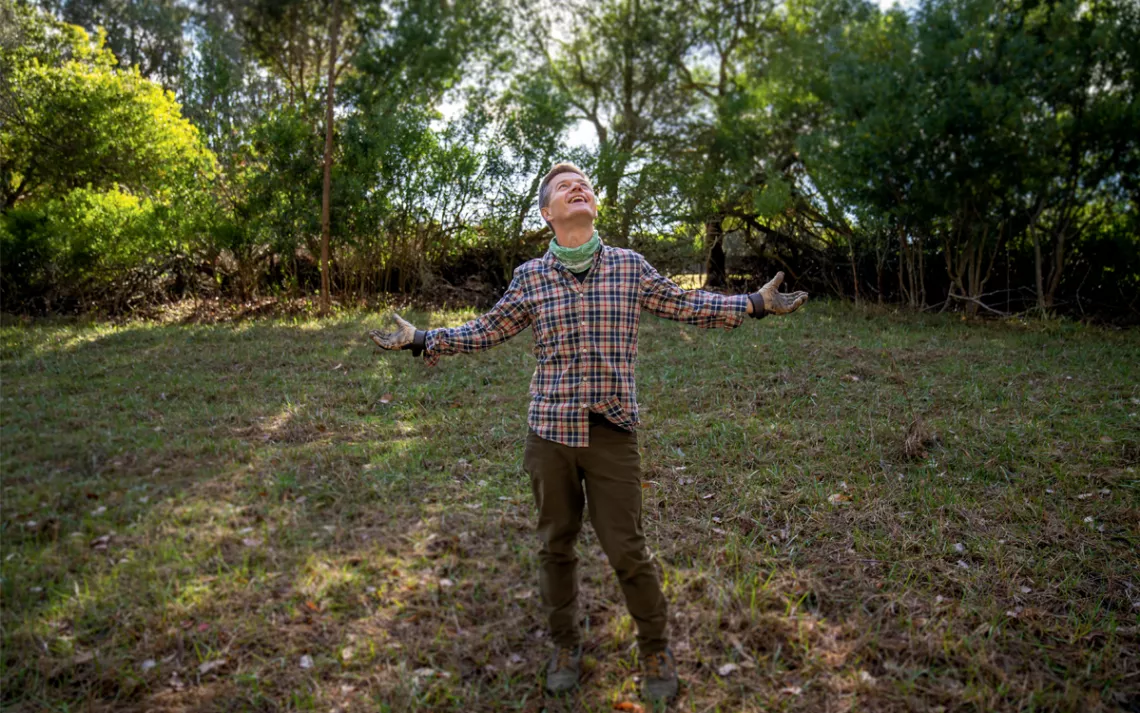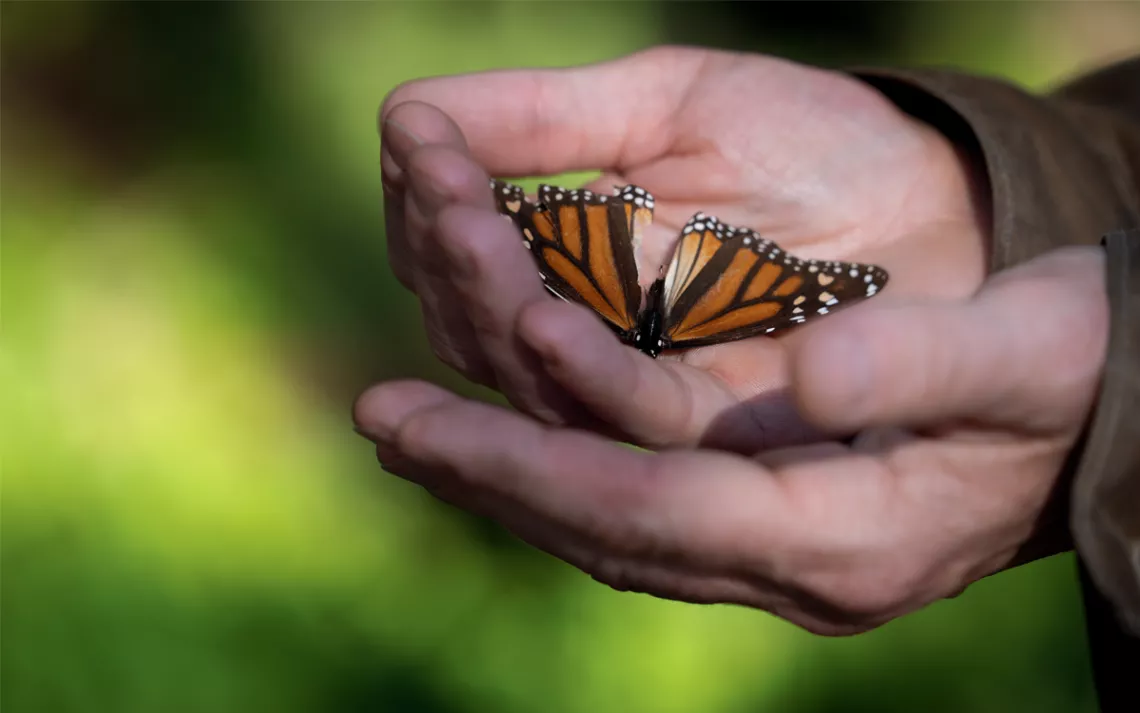Bringing Back Monarchs One Ranch at a Time
Ole Schell is helping to revive a once epic population of monarchs

Ole Schell at one of the monarch overwintering sites in Bolinas, California. | Photo by Nikki Kahn
When he was growing up in the coastal California village of Bolinas in the 1980s, Ole Schell remembers, the monarchs that returned each fall to their overwintering sites seemed "endless." They clustered in the eucalyptus and pine groves around town, sometimes in swarms so big that—Schell now recalls with embarrassment—he and his friends would shake the butterflies from the branches and watch them fly off by the hundreds. Along Terrace Avenue and at one vacant lot on Kale Road (yes, there's a Kale Road in the self-described "nature-loving town"), the clumps of monarchs appeared to number in the kajillions.
Schell eventually left home for broader horizons. He moved to New York City, where he worked as a documentary filmmaker. He traveled around the world for his various film projects. The monarchs of his childhood were a long way away.

Schell cradles a deceased butterfly. | Photo by Nikki Kahn
In 2016, Schell moved back to his family's cattle ranch on the northern edge of Bolinas. That winter, he was shocked to spot only one or two butterflies. The absence was glaring. But many of the locals—who had experienced the monarch diminishment as a steady decline instead of a sudden disappearance—seemed less alarmed. When Schell asked his mother about it, she said, "Yeah, there just aren't really monarchs anymore."
Perhaps Schell's relationship with monarchs would have ended there—curiosity bordering on concern. But then came the pandemic winter of 2020–21 and the collapse of the monarchs' overwintering population. In and around Bolinas, the census tallies from historic overwintering sites were a string of zeros: Terrace Avenue had none; Avenida Farralone in Stinson Beach had none; the youth hostel in the Marin Headlands had none. Statewide, only 1,600 monarchs were recorded that winter—less than 1 percent of the estimated 1.2 million that came to California in 1997, when the Western Monarch Count was launched.
"It was more than a decline—it was a disappearance. They were in an extinction vortex," Schell said. "It's not great to see a magical creature like that disappear." It felt like a nightmare in which you find yourself "naked and walking down the street."
In the midst of that pandemic winter, monarch advocates scrambled to protect the brilliant-orange insect. Mia Monroe, a career ranger at Muir Woods National Monument and a cofounder and volunteer coordinator of the Western Monarch Count, said she was swamped with calls and emails from people wondering how they could help. "I think the pandemic encouraged people to want to be outdoors, and then I think we all kind of realized that our world is imperiled, and then I think that monarchs became a species that matched those things," she said. Monroe tried to inspire people to get involved however they could—to "bring lessons into their classrooms" or to "plant gardens and welcome pollinators into their gardens."
What could Ole Schell do? Thanks to a good measure of luck and privilege, a lot. Schell soon cooked up a scheme to construct a butterfly sanctuary on the cattle ranch. The eucalyptus grove behind the shingled house his family had built from reclaimed wood in the 1970s was known as a historic overwintering site, even though it hadn't had monarchs for years. And the property—an epic spot that enjoys views of the Farallon Islands—had plenty of open space and, crucially, a year-round water source in the form of a pond. "I honestly had no idea what I was getting into," he said. "I mean, I was just in the position to do something. I had the land. I had the water . . . and I had time on my hands to do something like that."
On September 11, 2021, Schell broke ground on what he calls the West Marin Monarch Sanctuary. Schell and volunteers from the group Guardian Grange, which connects military veterans with wildlife conservation and regenerative agriculture projects, built a deer fence around a parcel located between the eucalyptus grove and the pond. They then began planting some 1,000 nectar plants of various types. The list of species came from the Xerces Society, the leading organization for the conservation of invertebrates, and SPAWN, a local nonprofit that runs a native plant nursery and provided many of the nectar plants. "We're creating a little haven," Schell said. "The goal is to create a monarch corridor."
The garden has since taken root and today is an emerging rainbow of nectar plants: ceanothus, lupine, coyote mint, seaside daisy, Mexican marigold, osoberry, elderberry, flowering currant. Schell has also started planting an orchard with fruit trees whose spring blooms can provide the nectar the butterflies need: plum, loquat, avocado, mulberry. "My vision is to do an agricultural farming operation in tandem with a butterfly operation—with helping the butterflies as the main objective," he said.
In late September 2022, for the first time, Schell spotted a butterfly on one of his nectar plants—a sight that made him "shriek with joy"—and he's seen more since. He's working to double the butterfly sanctuary to some 2,000 plants, and he's received a grant from the Marin Agricultural Land Trust to upgrade the ranch's irrigation systems. "So this has basically turned into my life," he said. "It's my full-time, nonpaying job. But when I see [the butterflies] coming back, it makes it all worthwhile."
When he considers all the sweat equity he's put into the project—the backbreaking work of the deer-fencing and rabbit-proofing, the irrigation snafus—Schell is humble to the point of self-deprecation. "I was just born into this ranch," he said. "I'm just some guy. I'm just some dude."
For Monroe, who has dedicated her entire adult life to monarch conservation, such modest beginnings are exactly what's required to make big social change. "Ole is a forerunner. Ole is unique," she said. "We want to go from unique to community. We need to see how to multiply. We want to create not only a community but a movement."
 The Magazine of The Sierra Club
The Magazine of The Sierra Club



